HA 3011: Enron and Walmart/Tesco Financial Accounting Analysis Report
VerifiedAdded on 2023/06/05
|14
|2929
|196
Report
AI Summary
This report provides a comprehensive analysis of the Enron case study, focusing on the factors that led to its corporate failure. The analysis delves into the use of mark-to-market accounting, special purpose entities, and employee stock options, highlighting how these practices contributed to the misr...
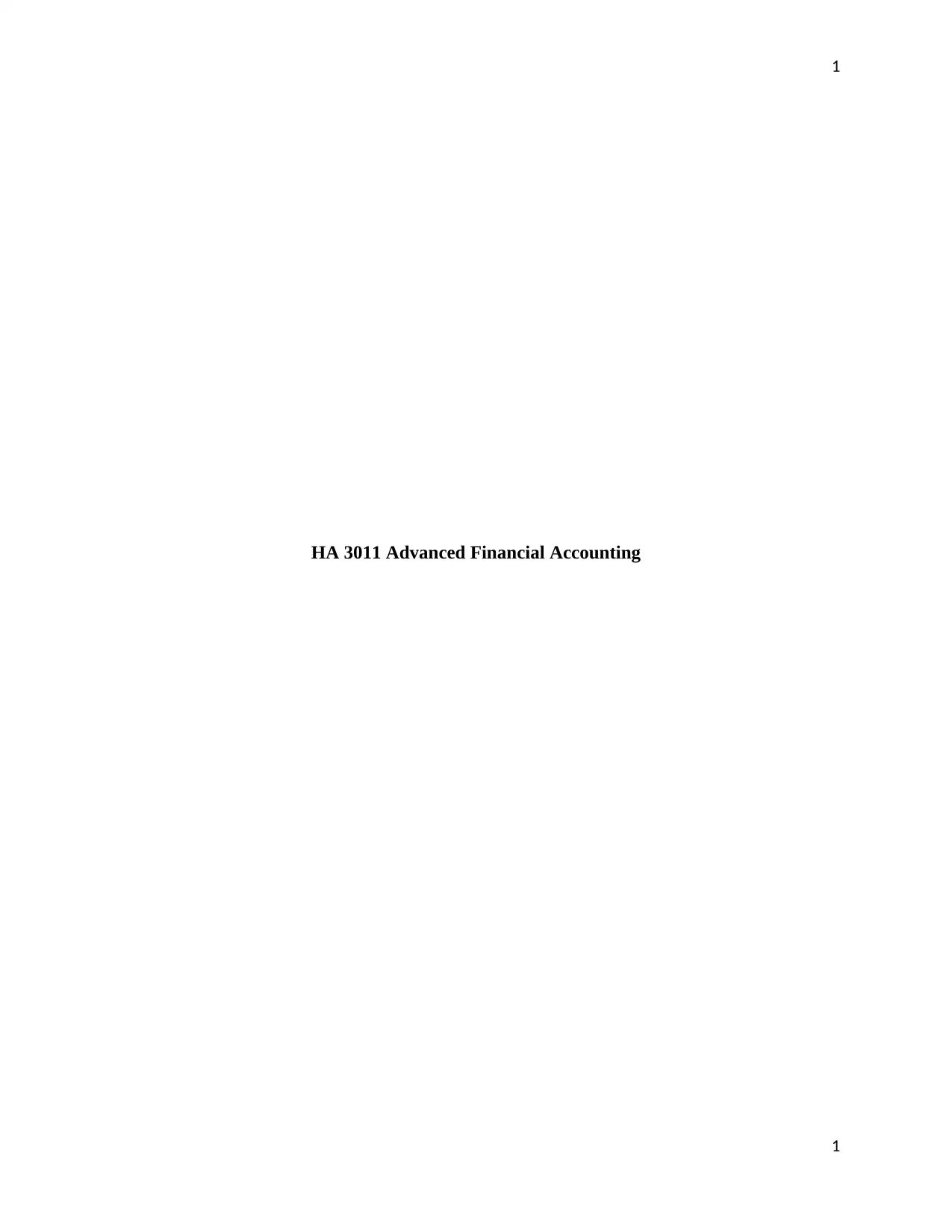
1
HA 3011 Advanced Financial Accounting
1
HA 3011 Advanced Financial Accounting
1
Paraphrase This Document
Need a fresh take? Get an instant paraphrase of this document with our AI Paraphraser
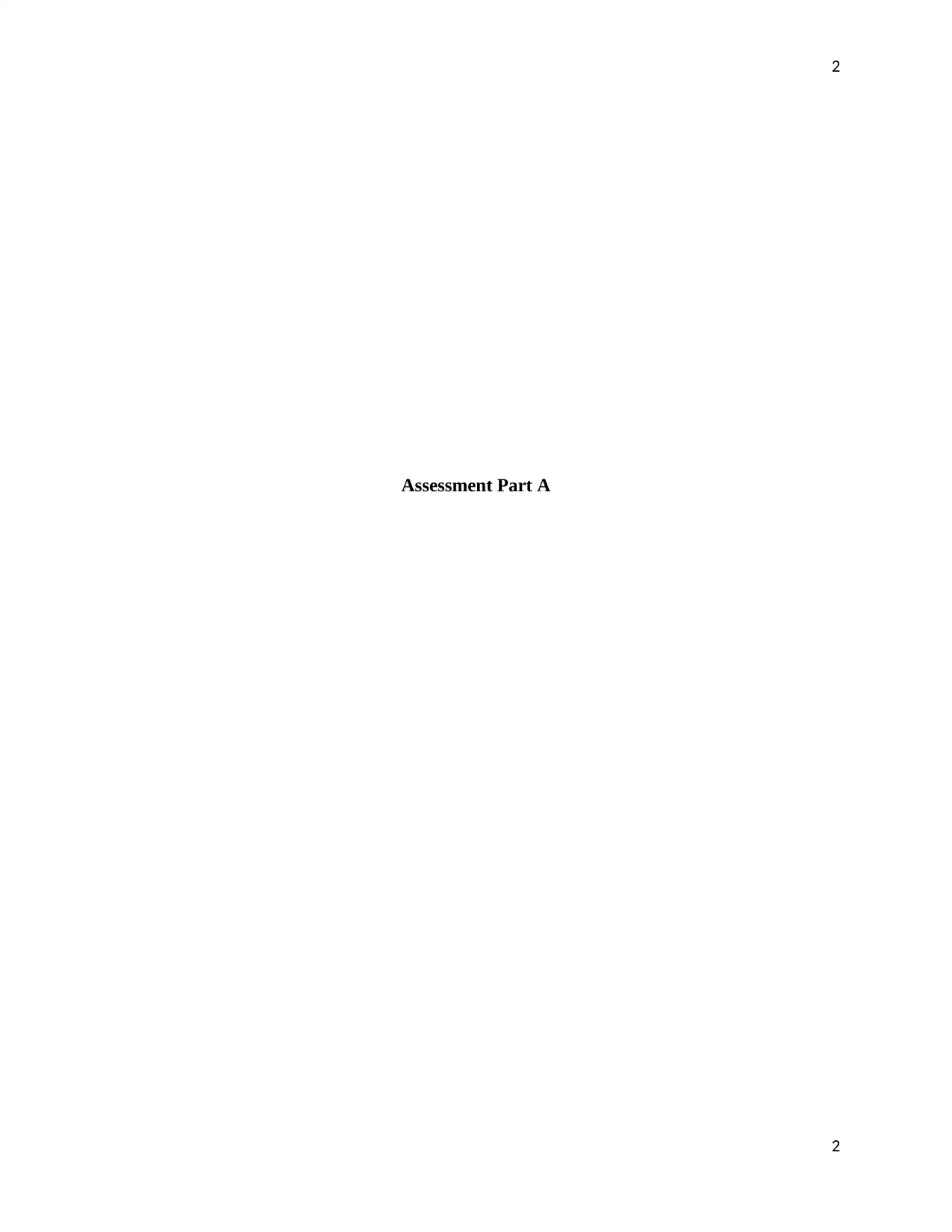
2
Assessment Part A
2
Assessment Part A
2
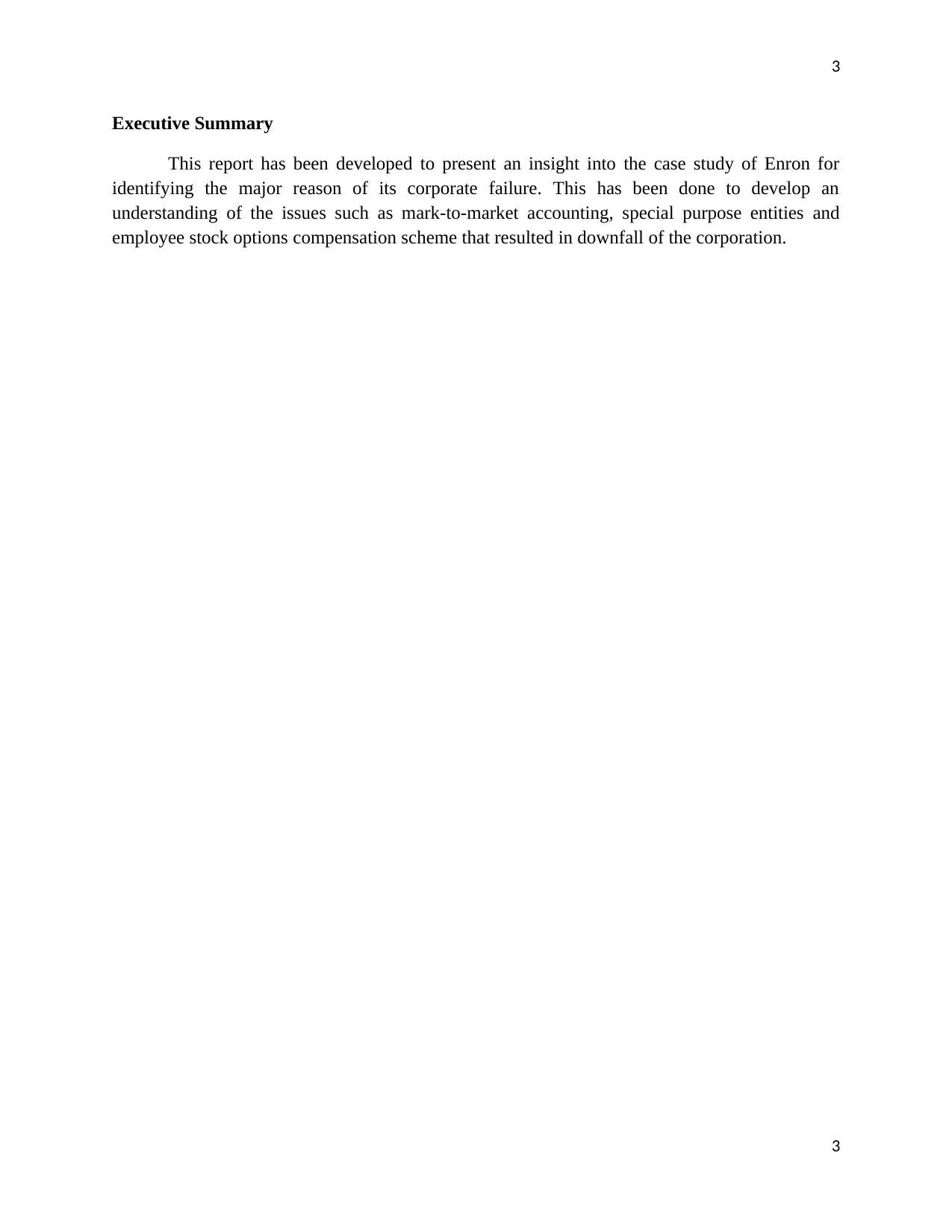
3
Executive Summary
This report has been developed to present an insight into the case study of Enron for
identifying the major reason of its corporate failure. This has been done to develop an
understanding of the issues such as mark-to-market accounting, special purpose entities and
employee stock options compensation scheme that resulted in downfall of the corporation.
3
Executive Summary
This report has been developed to present an insight into the case study of Enron for
identifying the major reason of its corporate failure. This has been done to develop an
understanding of the issues such as mark-to-market accounting, special purpose entities and
employee stock options compensation scheme that resulted in downfall of the corporation.
3
You're viewing a preview
Unlock full access by subscribing today!
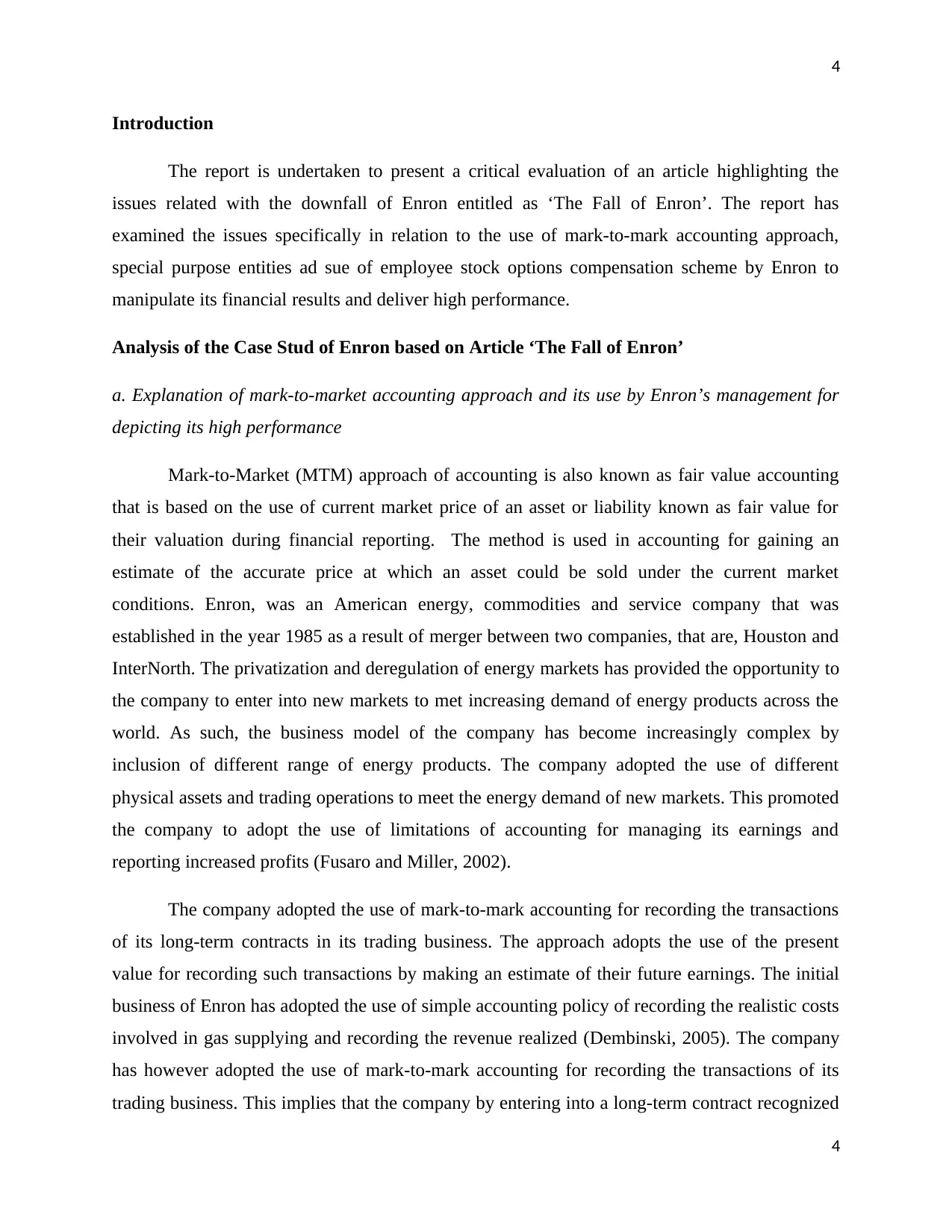
4
Introduction
The report is undertaken to present a critical evaluation of an article highlighting the
issues related with the downfall of Enron entitled as ‘The Fall of Enron’. The report has
examined the issues specifically in relation to the use of mark-to-mark accounting approach,
special purpose entities ad sue of employee stock options compensation scheme by Enron to
manipulate its financial results and deliver high performance.
Analysis of the Case Stud of Enron based on Article ‘The Fall of Enron’
a. Explanation of mark-to-market accounting approach and its use by Enron’s management for
depicting its high performance
Mark-to-Market (MTM) approach of accounting is also known as fair value accounting
that is based on the use of current market price of an asset or liability known as fair value for
their valuation during financial reporting. The method is used in accounting for gaining an
estimate of the accurate price at which an asset could be sold under the current market
conditions. Enron, was an American energy, commodities and service company that was
established in the year 1985 as a result of merger between two companies, that are, Houston and
InterNorth. The privatization and deregulation of energy markets has provided the opportunity to
the company to enter into new markets to met increasing demand of energy products across the
world. As such, the business model of the company has become increasingly complex by
inclusion of different range of energy products. The company adopted the use of different
physical assets and trading operations to meet the energy demand of new markets. This promoted
the company to adopt the use of limitations of accounting for managing its earnings and
reporting increased profits (Fusaro and Miller, 2002).
The company adopted the use of mark-to-mark accounting for recording the transactions
of its long-term contracts in its trading business. The approach adopts the use of the present
value for recording such transactions by making an estimate of their future earnings. The initial
business of Enron has adopted the use of simple accounting policy of recording the realistic costs
involved in gas supplying and recording the revenue realized (Dembinski, 2005). The company
has however adopted the use of mark-to-mark accounting for recording the transactions of its
trading business. This implies that the company by entering into a long-term contract recognized
4
Introduction
The report is undertaken to present a critical evaluation of an article highlighting the
issues related with the downfall of Enron entitled as ‘The Fall of Enron’. The report has
examined the issues specifically in relation to the use of mark-to-mark accounting approach,
special purpose entities ad sue of employee stock options compensation scheme by Enron to
manipulate its financial results and deliver high performance.
Analysis of the Case Stud of Enron based on Article ‘The Fall of Enron’
a. Explanation of mark-to-market accounting approach and its use by Enron’s management for
depicting its high performance
Mark-to-Market (MTM) approach of accounting is also known as fair value accounting
that is based on the use of current market price of an asset or liability known as fair value for
their valuation during financial reporting. The method is used in accounting for gaining an
estimate of the accurate price at which an asset could be sold under the current market
conditions. Enron, was an American energy, commodities and service company that was
established in the year 1985 as a result of merger between two companies, that are, Houston and
InterNorth. The privatization and deregulation of energy markets has provided the opportunity to
the company to enter into new markets to met increasing demand of energy products across the
world. As such, the business model of the company has become increasingly complex by
inclusion of different range of energy products. The company adopted the use of different
physical assets and trading operations to meet the energy demand of new markets. This promoted
the company to adopt the use of limitations of accounting for managing its earnings and
reporting increased profits (Fusaro and Miller, 2002).
The company adopted the use of mark-to-mark accounting for recording the transactions
of its long-term contracts in its trading business. The approach adopts the use of the present
value for recording such transactions by making an estimate of their future earnings. The initial
business of Enron has adopted the use of simple accounting policy of recording the realistic costs
involved in gas supplying and recording the revenue realized (Dembinski, 2005). The company
has however adopted the use of mark-to-mark accounting for recording the transactions of its
trading business. This implies that the company by entering into a long-term contract recognized
4
Paraphrase This Document
Need a fresh take? Get an instant paraphrase of this document with our AI Paraphraser
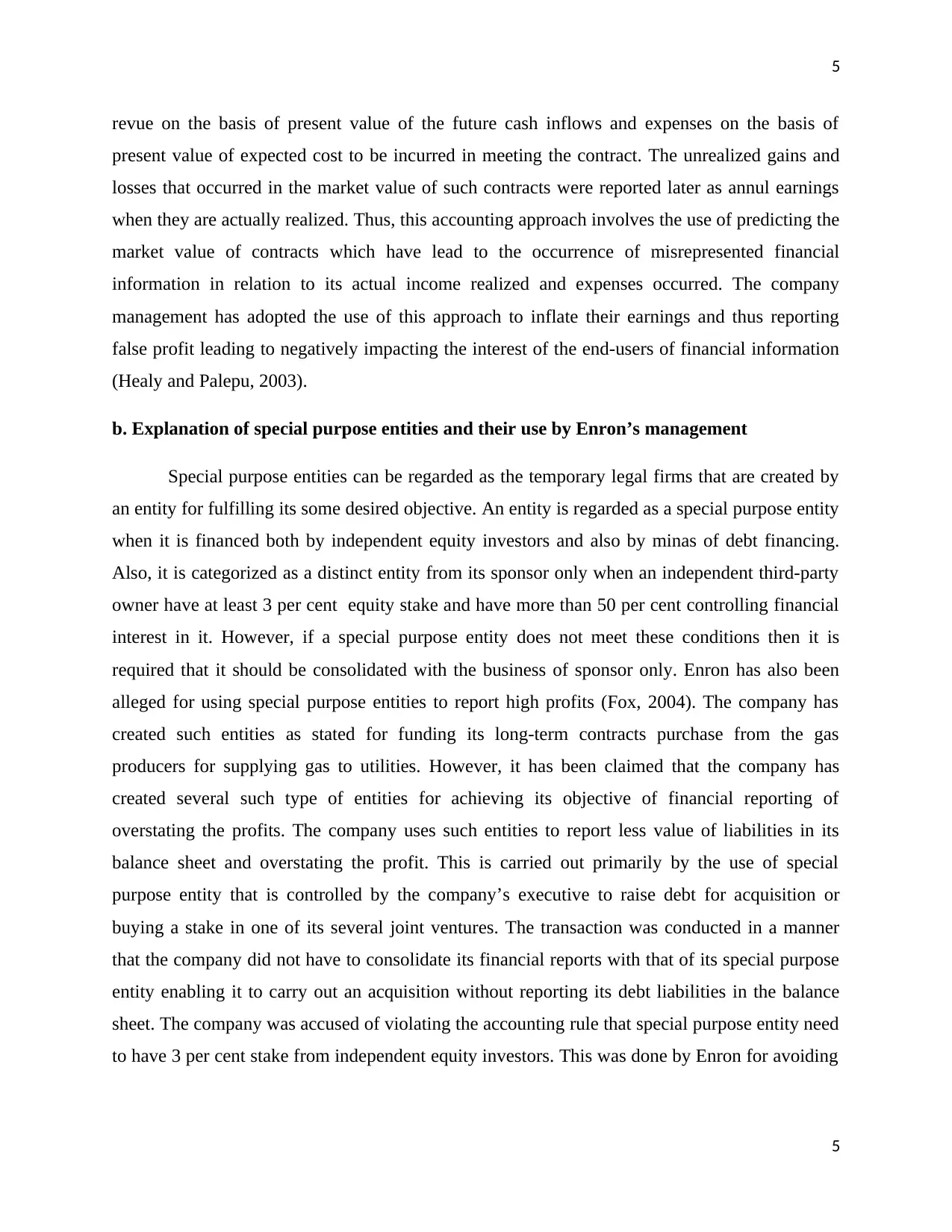
5
revue on the basis of present value of the future cash inflows and expenses on the basis of
present value of expected cost to be incurred in meeting the contract. The unrealized gains and
losses that occurred in the market value of such contracts were reported later as annul earnings
when they are actually realized. Thus, this accounting approach involves the use of predicting the
market value of contracts which have lead to the occurrence of misrepresented financial
information in relation to its actual income realized and expenses occurred. The company
management has adopted the use of this approach to inflate their earnings and thus reporting
false profit leading to negatively impacting the interest of the end-users of financial information
(Healy and Palepu, 2003).
b. Explanation of special purpose entities and their use by Enron’s management
Special purpose entities can be regarded as the temporary legal firms that are created by
an entity for fulfilling its some desired objective. An entity is regarded as a special purpose entity
when it is financed both by independent equity investors and also by minas of debt financing.
Also, it is categorized as a distinct entity from its sponsor only when an independent third-party
owner have at least 3 per cent equity stake and have more than 50 per cent controlling financial
interest in it. However, if a special purpose entity does not meet these conditions then it is
required that it should be consolidated with the business of sponsor only. Enron has also been
alleged for using special purpose entities to report high profits (Fox, 2004). The company has
created such entities as stated for funding its long-term contracts purchase from the gas
producers for supplying gas to utilities. However, it has been claimed that the company has
created several such type of entities for achieving its objective of financial reporting of
overstating the profits. The company uses such entities to report less value of liabilities in its
balance sheet and overstating the profit. This is carried out primarily by the use of special
purpose entity that is controlled by the company’s executive to raise debt for acquisition or
buying a stake in one of its several joint ventures. The transaction was conducted in a manner
that the company did not have to consolidate its financial reports with that of its special purpose
entity enabling it to carry out an acquisition without reporting its debt liabilities in the balance
sheet. The company was accused of violating the accounting rule that special purpose entity need
to have 3 per cent stake from independent equity investors. This was done by Enron for avoiding
5
revue on the basis of present value of the future cash inflows and expenses on the basis of
present value of expected cost to be incurred in meeting the contract. The unrealized gains and
losses that occurred in the market value of such contracts were reported later as annul earnings
when they are actually realized. Thus, this accounting approach involves the use of predicting the
market value of contracts which have lead to the occurrence of misrepresented financial
information in relation to its actual income realized and expenses occurred. The company
management has adopted the use of this approach to inflate their earnings and thus reporting
false profit leading to negatively impacting the interest of the end-users of financial information
(Healy and Palepu, 2003).
b. Explanation of special purpose entities and their use by Enron’s management
Special purpose entities can be regarded as the temporary legal firms that are created by
an entity for fulfilling its some desired objective. An entity is regarded as a special purpose entity
when it is financed both by independent equity investors and also by minas of debt financing.
Also, it is categorized as a distinct entity from its sponsor only when an independent third-party
owner have at least 3 per cent equity stake and have more than 50 per cent controlling financial
interest in it. However, if a special purpose entity does not meet these conditions then it is
required that it should be consolidated with the business of sponsor only. Enron has also been
alleged for using special purpose entities to report high profits (Fox, 2004). The company has
created such entities as stated for funding its long-term contracts purchase from the gas
producers for supplying gas to utilities. However, it has been claimed that the company has
created several such type of entities for achieving its objective of financial reporting of
overstating the profits. The company uses such entities to report less value of liabilities in its
balance sheet and overstating the profit. This is carried out primarily by the use of special
purpose entity that is controlled by the company’s executive to raise debt for acquisition or
buying a stake in one of its several joint ventures. The transaction was conducted in a manner
that the company did not have to consolidate its financial reports with that of its special purpose
entity enabling it to carry out an acquisition without reporting its debt liabilities in the balance
sheet. The company was accused of violating the accounting rule that special purpose entity need
to have 3 per cent stake from independent equity investors. This was done by Enron for avoiding
5
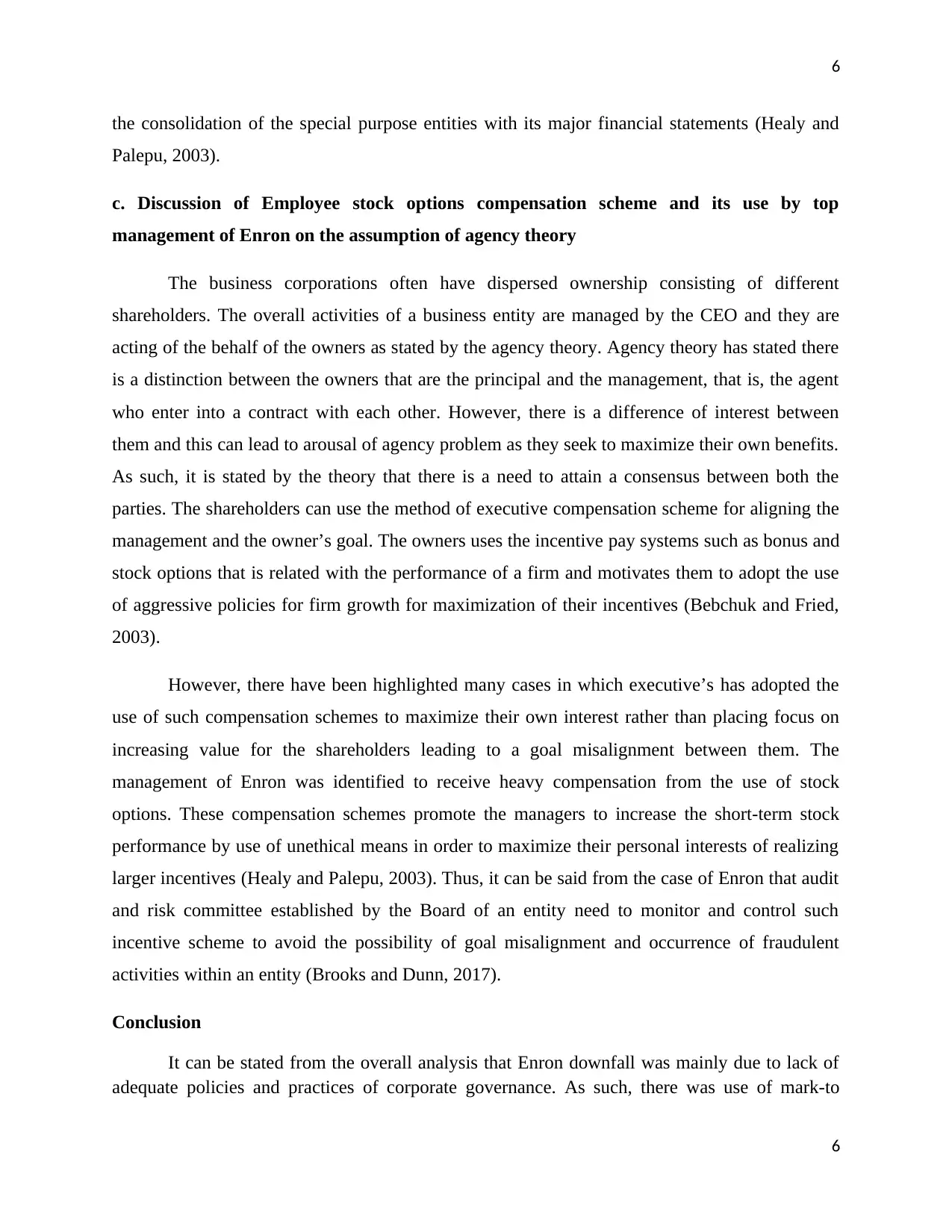
6
the consolidation of the special purpose entities with its major financial statements (Healy and
Palepu, 2003).
c. Discussion of Employee stock options compensation scheme and its use by top
management of Enron on the assumption of agency theory
The business corporations often have dispersed ownership consisting of different
shareholders. The overall activities of a business entity are managed by the CEO and they are
acting of the behalf of the owners as stated by the agency theory. Agency theory has stated there
is a distinction between the owners that are the principal and the management, that is, the agent
who enter into a contract with each other. However, there is a difference of interest between
them and this can lead to arousal of agency problem as they seek to maximize their own benefits.
As such, it is stated by the theory that there is a need to attain a consensus between both the
parties. The shareholders can use the method of executive compensation scheme for aligning the
management and the owner’s goal. The owners uses the incentive pay systems such as bonus and
stock options that is related with the performance of a firm and motivates them to adopt the use
of aggressive policies for firm growth for maximization of their incentives (Bebchuk and Fried,
2003).
However, there have been highlighted many cases in which executive’s has adopted the
use of such compensation schemes to maximize their own interest rather than placing focus on
increasing value for the shareholders leading to a goal misalignment between them. The
management of Enron was identified to receive heavy compensation from the use of stock
options. These compensation schemes promote the managers to increase the short-term stock
performance by use of unethical means in order to maximize their personal interests of realizing
larger incentives (Healy and Palepu, 2003). Thus, it can be said from the case of Enron that audit
and risk committee established by the Board of an entity need to monitor and control such
incentive scheme to avoid the possibility of goal misalignment and occurrence of fraudulent
activities within an entity (Brooks and Dunn, 2017).
Conclusion
It can be stated from the overall analysis that Enron downfall was mainly due to lack of
adequate policies and practices of corporate governance. As such, there was use of mark-to
6
the consolidation of the special purpose entities with its major financial statements (Healy and
Palepu, 2003).
c. Discussion of Employee stock options compensation scheme and its use by top
management of Enron on the assumption of agency theory
The business corporations often have dispersed ownership consisting of different
shareholders. The overall activities of a business entity are managed by the CEO and they are
acting of the behalf of the owners as stated by the agency theory. Agency theory has stated there
is a distinction between the owners that are the principal and the management, that is, the agent
who enter into a contract with each other. However, there is a difference of interest between
them and this can lead to arousal of agency problem as they seek to maximize their own benefits.
As such, it is stated by the theory that there is a need to attain a consensus between both the
parties. The shareholders can use the method of executive compensation scheme for aligning the
management and the owner’s goal. The owners uses the incentive pay systems such as bonus and
stock options that is related with the performance of a firm and motivates them to adopt the use
of aggressive policies for firm growth for maximization of their incentives (Bebchuk and Fried,
2003).
However, there have been highlighted many cases in which executive’s has adopted the
use of such compensation schemes to maximize their own interest rather than placing focus on
increasing value for the shareholders leading to a goal misalignment between them. The
management of Enron was identified to receive heavy compensation from the use of stock
options. These compensation schemes promote the managers to increase the short-term stock
performance by use of unethical means in order to maximize their personal interests of realizing
larger incentives (Healy and Palepu, 2003). Thus, it can be said from the case of Enron that audit
and risk committee established by the Board of an entity need to monitor and control such
incentive scheme to avoid the possibility of goal misalignment and occurrence of fraudulent
activities within an entity (Brooks and Dunn, 2017).
Conclusion
It can be stated from the overall analysis that Enron downfall was mainly due to lack of
adequate policies and practices of corporate governance. As such, there was use of mark-to
6
You're viewing a preview
Unlock full access by subscribing today!
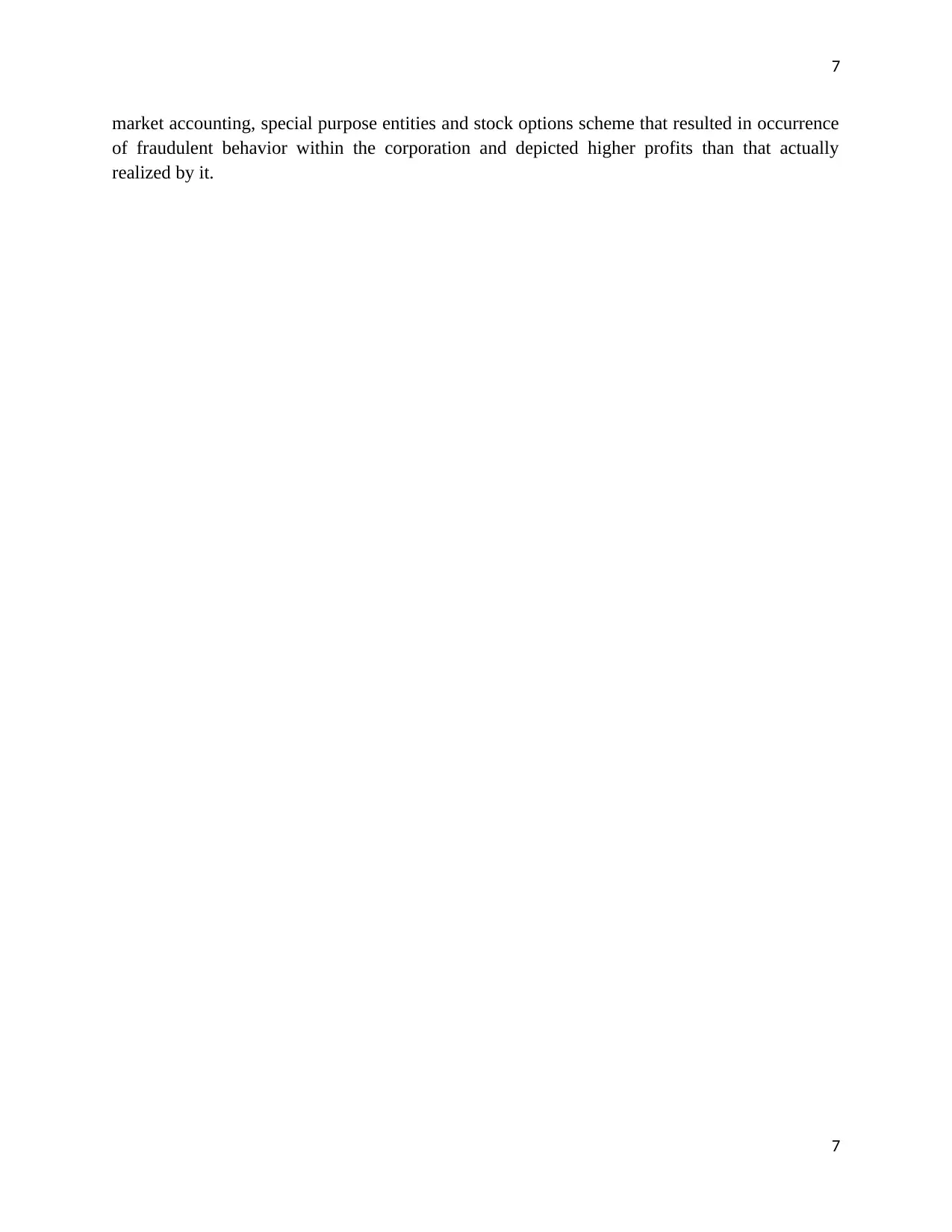
7
market accounting, special purpose entities and stock options scheme that resulted in occurrence
of fraudulent behavior within the corporation and depicted higher profits than that actually
realized by it.
7
market accounting, special purpose entities and stock options scheme that resulted in occurrence
of fraudulent behavior within the corporation and depicted higher profits than that actually
realized by it.
7
Paraphrase This Document
Need a fresh take? Get an instant paraphrase of this document with our AI Paraphraser
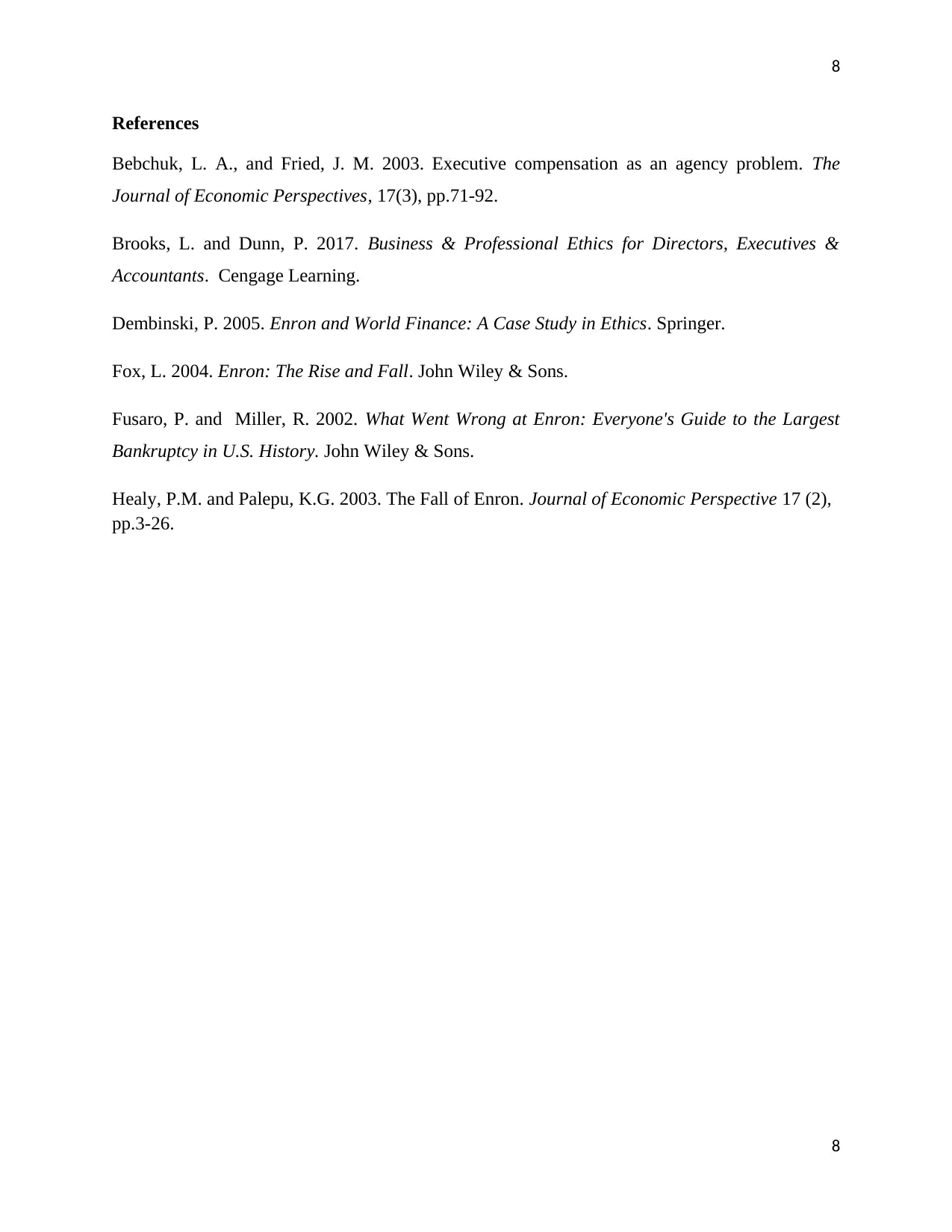
8
References
Bebchuk, L. A., and Fried, J. M. 2003. Executive compensation as an agency problem. The
Journal of Economic Perspectives, 17(3), pp.71-92.
Brooks, L. and Dunn, P. 2017. Business & Professional Ethics for Directors, Executives &
Accountants. Cengage Learning.
Dembinski, P. 2005. Enron and World Finance: A Case Study in Ethics. Springer.
Fox, L. 2004. Enron: The Rise and Fall. John Wiley & Sons.
Fusaro, P. and Miller, R. 2002. What Went Wrong at Enron: Everyone's Guide to the Largest
Bankruptcy in U.S. History. John Wiley & Sons.
Healy, P.M. and Palepu, K.G. 2003. The Fall of Enron. Journal of Economic Perspective 17 (2),
pp.3-26.
8
References
Bebchuk, L. A., and Fried, J. M. 2003. Executive compensation as an agency problem. The
Journal of Economic Perspectives, 17(3), pp.71-92.
Brooks, L. and Dunn, P. 2017. Business & Professional Ethics for Directors, Executives &
Accountants. Cengage Learning.
Dembinski, P. 2005. Enron and World Finance: A Case Study in Ethics. Springer.
Fox, L. 2004. Enron: The Rise and Fall. John Wiley & Sons.
Fusaro, P. and Miller, R. 2002. What Went Wrong at Enron: Everyone's Guide to the Largest
Bankruptcy in U.S. History. John Wiley & Sons.
Healy, P.M. and Palepu, K.G. 2003. The Fall of Enron. Journal of Economic Perspective 17 (2),
pp.3-26.
8
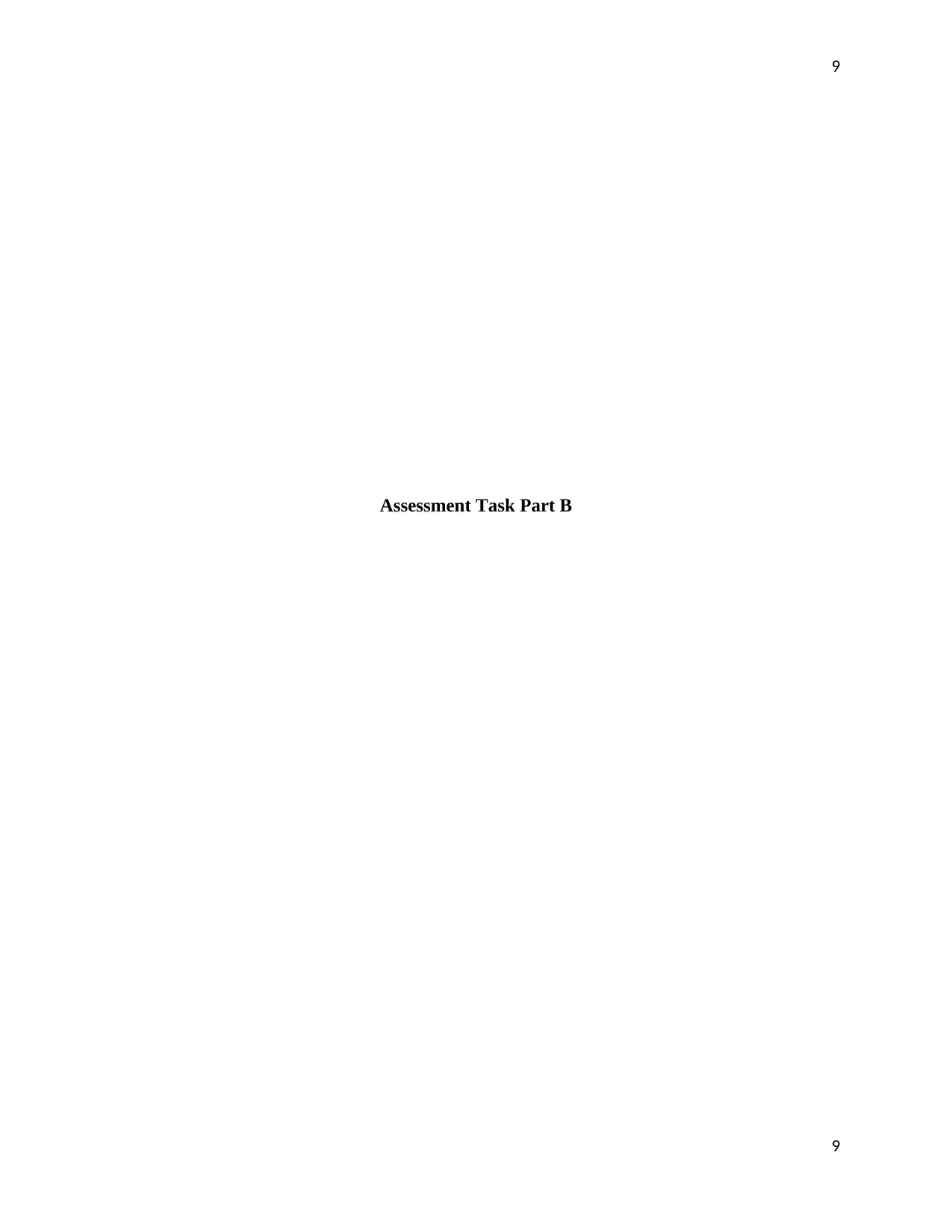
9
Assessment Task Part B
9
Assessment Task Part B
9
You're viewing a preview
Unlock full access by subscribing today!
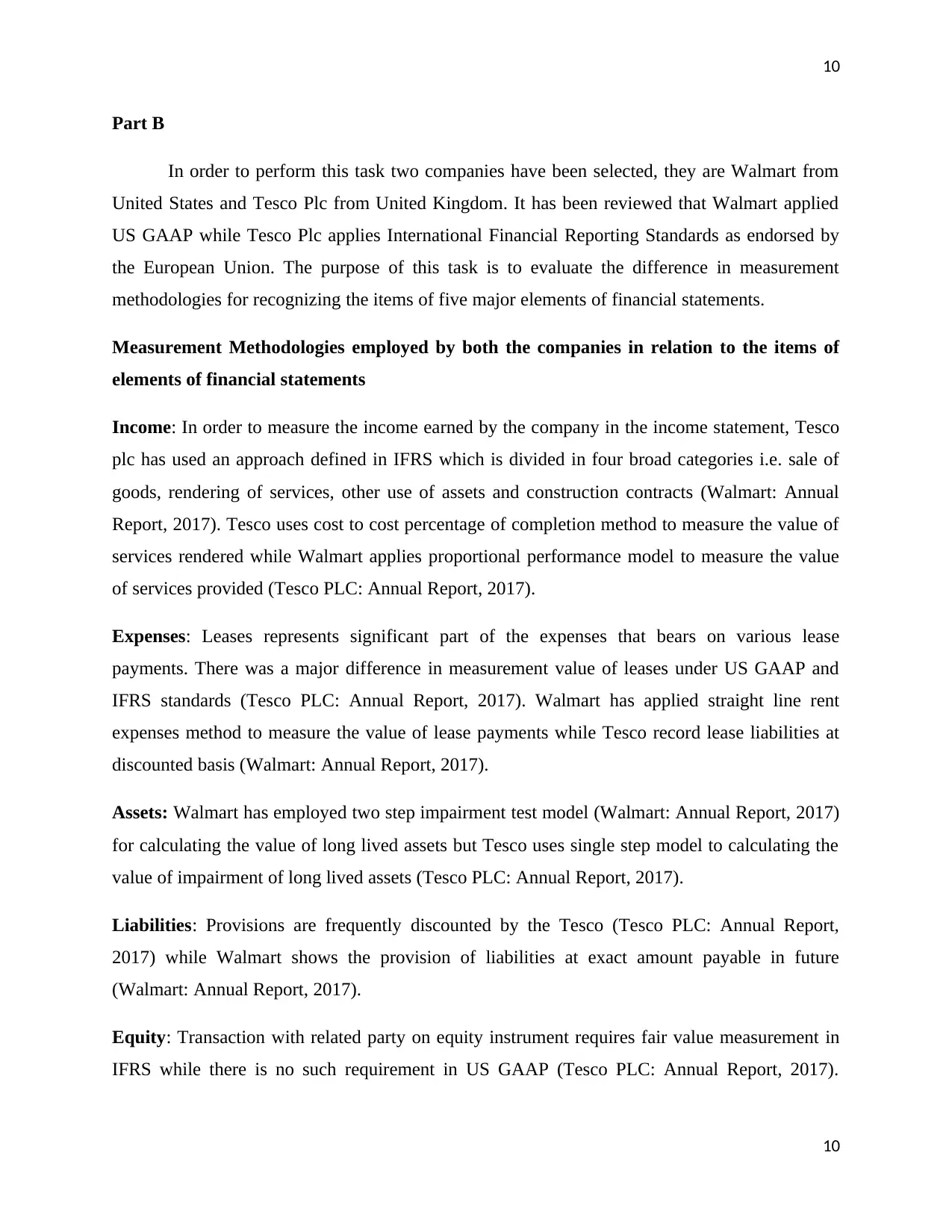
10
Part B
In order to perform this task two companies have been selected, they are Walmart from
United States and Tesco Plc from United Kingdom. It has been reviewed that Walmart applied
US GAAP while Tesco Plc applies International Financial Reporting Standards as endorsed by
the European Union. The purpose of this task is to evaluate the difference in measurement
methodologies for recognizing the items of five major elements of financial statements.
Measurement Methodologies employed by both the companies in relation to the items of
elements of financial statements
Income: In order to measure the income earned by the company in the income statement, Tesco
plc has used an approach defined in IFRS which is divided in four broad categories i.e. sale of
goods, rendering of services, other use of assets and construction contracts (Walmart: Annual
Report, 2017). Tesco uses cost to cost percentage of completion method to measure the value of
services rendered while Walmart applies proportional performance model to measure the value
of services provided (Tesco PLC: Annual Report, 2017).
Expenses: Leases represents significant part of the expenses that bears on various lease
payments. There was a major difference in measurement value of leases under US GAAP and
IFRS standards (Tesco PLC: Annual Report, 2017). Walmart has applied straight line rent
expenses method to measure the value of lease payments while Tesco record lease liabilities at
discounted basis (Walmart: Annual Report, 2017).
Assets: Walmart has employed two step impairment test model (Walmart: Annual Report, 2017)
for calculating the value of long lived assets but Tesco uses single step model to calculating the
value of impairment of long lived assets (Tesco PLC: Annual Report, 2017).
Liabilities: Provisions are frequently discounted by the Tesco (Tesco PLC: Annual Report,
2017) while Walmart shows the provision of liabilities at exact amount payable in future
(Walmart: Annual Report, 2017).
Equity: Transaction with related party on equity instrument requires fair value measurement in
IFRS while there is no such requirement in US GAAP (Tesco PLC: Annual Report, 2017).
10
Part B
In order to perform this task two companies have been selected, they are Walmart from
United States and Tesco Plc from United Kingdom. It has been reviewed that Walmart applied
US GAAP while Tesco Plc applies International Financial Reporting Standards as endorsed by
the European Union. The purpose of this task is to evaluate the difference in measurement
methodologies for recognizing the items of five major elements of financial statements.
Measurement Methodologies employed by both the companies in relation to the items of
elements of financial statements
Income: In order to measure the income earned by the company in the income statement, Tesco
plc has used an approach defined in IFRS which is divided in four broad categories i.e. sale of
goods, rendering of services, other use of assets and construction contracts (Walmart: Annual
Report, 2017). Tesco uses cost to cost percentage of completion method to measure the value of
services rendered while Walmart applies proportional performance model to measure the value
of services provided (Tesco PLC: Annual Report, 2017).
Expenses: Leases represents significant part of the expenses that bears on various lease
payments. There was a major difference in measurement value of leases under US GAAP and
IFRS standards (Tesco PLC: Annual Report, 2017). Walmart has applied straight line rent
expenses method to measure the value of lease payments while Tesco record lease liabilities at
discounted basis (Walmart: Annual Report, 2017).
Assets: Walmart has employed two step impairment test model (Walmart: Annual Report, 2017)
for calculating the value of long lived assets but Tesco uses single step model to calculating the
value of impairment of long lived assets (Tesco PLC: Annual Report, 2017).
Liabilities: Provisions are frequently discounted by the Tesco (Tesco PLC: Annual Report,
2017) while Walmart shows the provision of liabilities at exact amount payable in future
(Walmart: Annual Report, 2017).
Equity: Transaction with related party on equity instrument requires fair value measurement in
IFRS while there is no such requirement in US GAAP (Tesco PLC: Annual Report, 2017).
10
Paraphrase This Document
Need a fresh take? Get an instant paraphrase of this document with our AI Paraphraser
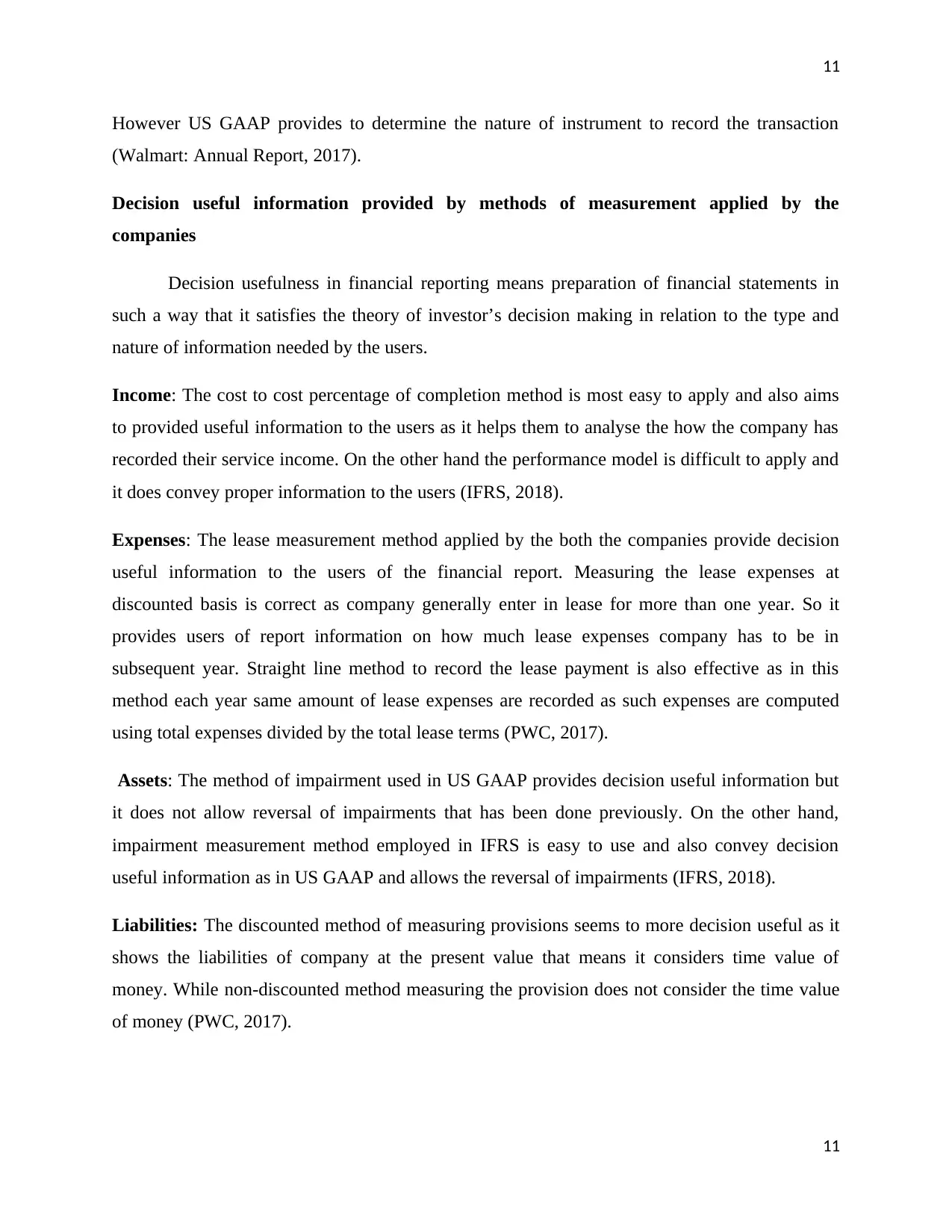
11
However US GAAP provides to determine the nature of instrument to record the transaction
(Walmart: Annual Report, 2017).
Decision useful information provided by methods of measurement applied by the
companies
Decision usefulness in financial reporting means preparation of financial statements in
such a way that it satisfies the theory of investor’s decision making in relation to the type and
nature of information needed by the users.
Income: The cost to cost percentage of completion method is most easy to apply and also aims
to provided useful information to the users as it helps them to analyse the how the company has
recorded their service income. On the other hand the performance model is difficult to apply and
it does convey proper information to the users (IFRS, 2018).
Expenses: The lease measurement method applied by the both the companies provide decision
useful information to the users of the financial report. Measuring the lease expenses at
discounted basis is correct as company generally enter in lease for more than one year. So it
provides users of report information on how much lease expenses company has to be in
subsequent year. Straight line method to record the lease payment is also effective as in this
method each year same amount of lease expenses are recorded as such expenses are computed
using total expenses divided by the total lease terms (PWC, 2017).
Assets: The method of impairment used in US GAAP provides decision useful information but
it does not allow reversal of impairments that has been done previously. On the other hand,
impairment measurement method employed in IFRS is easy to use and also convey decision
useful information as in US GAAP and allows the reversal of impairments (IFRS, 2018).
Liabilities: The discounted method of measuring provisions seems to more decision useful as it
shows the liabilities of company at the present value that means it considers time value of
money. While non-discounted method measuring the provision does not consider the time value
of money (PWC, 2017).
11
However US GAAP provides to determine the nature of instrument to record the transaction
(Walmart: Annual Report, 2017).
Decision useful information provided by methods of measurement applied by the
companies
Decision usefulness in financial reporting means preparation of financial statements in
such a way that it satisfies the theory of investor’s decision making in relation to the type and
nature of information needed by the users.
Income: The cost to cost percentage of completion method is most easy to apply and also aims
to provided useful information to the users as it helps them to analyse the how the company has
recorded their service income. On the other hand the performance model is difficult to apply and
it does convey proper information to the users (IFRS, 2018).
Expenses: The lease measurement method applied by the both the companies provide decision
useful information to the users of the financial report. Measuring the lease expenses at
discounted basis is correct as company generally enter in lease for more than one year. So it
provides users of report information on how much lease expenses company has to be in
subsequent year. Straight line method to record the lease payment is also effective as in this
method each year same amount of lease expenses are recorded as such expenses are computed
using total expenses divided by the total lease terms (PWC, 2017).
Assets: The method of impairment used in US GAAP provides decision useful information but
it does not allow reversal of impairments that has been done previously. On the other hand,
impairment measurement method employed in IFRS is easy to use and also convey decision
useful information as in US GAAP and allows the reversal of impairments (IFRS, 2018).
Liabilities: The discounted method of measuring provisions seems to more decision useful as it
shows the liabilities of company at the present value that means it considers time value of
money. While non-discounted method measuring the provision does not consider the time value
of money (PWC, 2017).
11
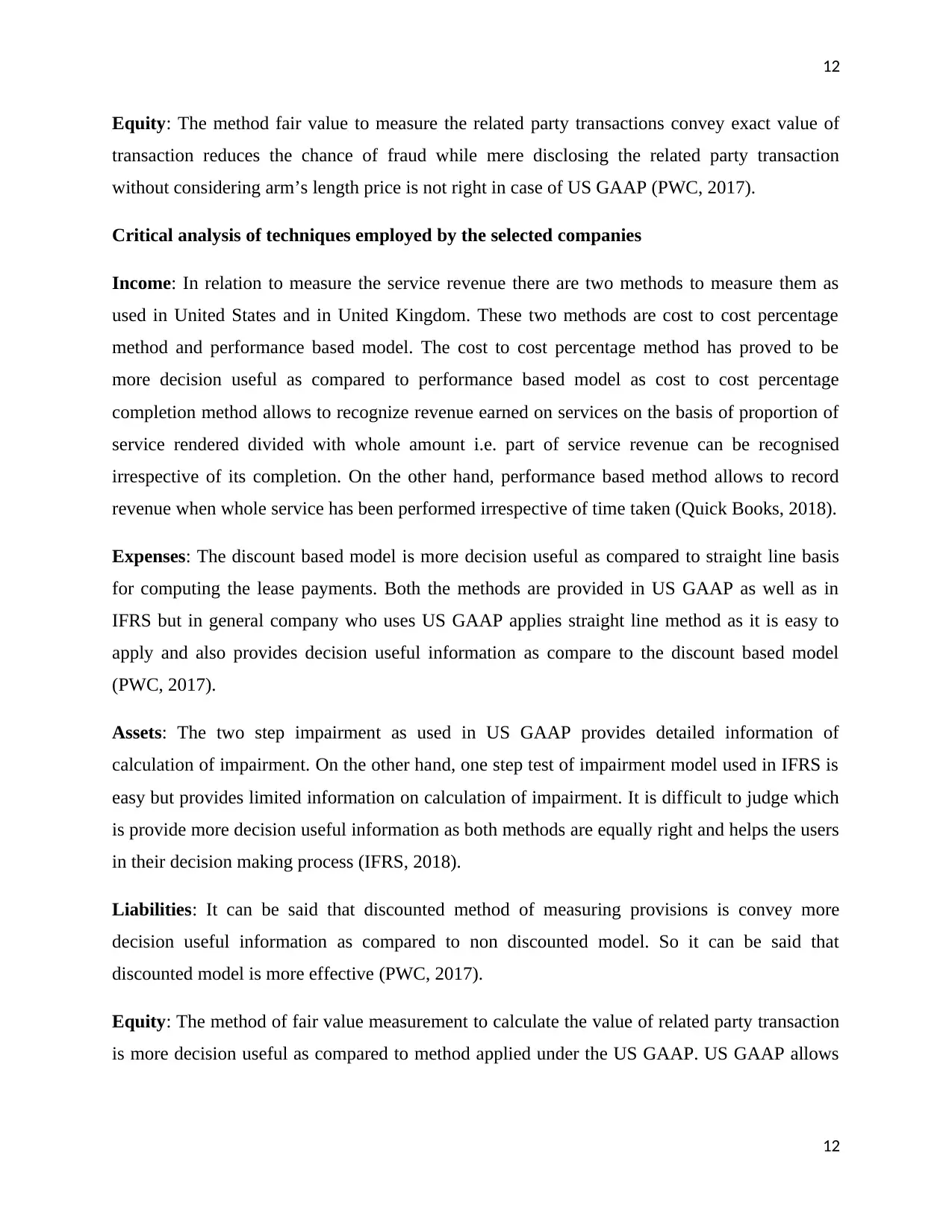
12
Equity: The method fair value to measure the related party transactions convey exact value of
transaction reduces the chance of fraud while mere disclosing the related party transaction
without considering arm’s length price is not right in case of US GAAP (PWC, 2017).
Critical analysis of techniques employed by the selected companies
Income: In relation to measure the service revenue there are two methods to measure them as
used in United States and in United Kingdom. These two methods are cost to cost percentage
method and performance based model. The cost to cost percentage method has proved to be
more decision useful as compared to performance based model as cost to cost percentage
completion method allows to recognize revenue earned on services on the basis of proportion of
service rendered divided with whole amount i.e. part of service revenue can be recognised
irrespective of its completion. On the other hand, performance based method allows to record
revenue when whole service has been performed irrespective of time taken (Quick Books, 2018).
Expenses: The discount based model is more decision useful as compared to straight line basis
for computing the lease payments. Both the methods are provided in US GAAP as well as in
IFRS but in general company who uses US GAAP applies straight line method as it is easy to
apply and also provides decision useful information as compare to the discount based model
(PWC, 2017).
Assets: The two step impairment as used in US GAAP provides detailed information of
calculation of impairment. On the other hand, one step test of impairment model used in IFRS is
easy but provides limited information on calculation of impairment. It is difficult to judge which
is provide more decision useful information as both methods are equally right and helps the users
in their decision making process (IFRS, 2018).
Liabilities: It can be said that discounted method of measuring provisions is convey more
decision useful information as compared to non discounted model. So it can be said that
discounted model is more effective (PWC, 2017).
Equity: The method of fair value measurement to calculate the value of related party transaction
is more decision useful as compared to method applied under the US GAAP. US GAAP allows
12
Equity: The method fair value to measure the related party transactions convey exact value of
transaction reduces the chance of fraud while mere disclosing the related party transaction
without considering arm’s length price is not right in case of US GAAP (PWC, 2017).
Critical analysis of techniques employed by the selected companies
Income: In relation to measure the service revenue there are two methods to measure them as
used in United States and in United Kingdom. These two methods are cost to cost percentage
method and performance based model. The cost to cost percentage method has proved to be
more decision useful as compared to performance based model as cost to cost percentage
completion method allows to recognize revenue earned on services on the basis of proportion of
service rendered divided with whole amount i.e. part of service revenue can be recognised
irrespective of its completion. On the other hand, performance based method allows to record
revenue when whole service has been performed irrespective of time taken (Quick Books, 2018).
Expenses: The discount based model is more decision useful as compared to straight line basis
for computing the lease payments. Both the methods are provided in US GAAP as well as in
IFRS but in general company who uses US GAAP applies straight line method as it is easy to
apply and also provides decision useful information as compare to the discount based model
(PWC, 2017).
Assets: The two step impairment as used in US GAAP provides detailed information of
calculation of impairment. On the other hand, one step test of impairment model used in IFRS is
easy but provides limited information on calculation of impairment. It is difficult to judge which
is provide more decision useful information as both methods are equally right and helps the users
in their decision making process (IFRS, 2018).
Liabilities: It can be said that discounted method of measuring provisions is convey more
decision useful information as compared to non discounted model. So it can be said that
discounted model is more effective (PWC, 2017).
Equity: The method of fair value measurement to calculate the value of related party transaction
is more decision useful as compared to method applied under the US GAAP. US GAAP allows
12
You're viewing a preview
Unlock full access by subscribing today!
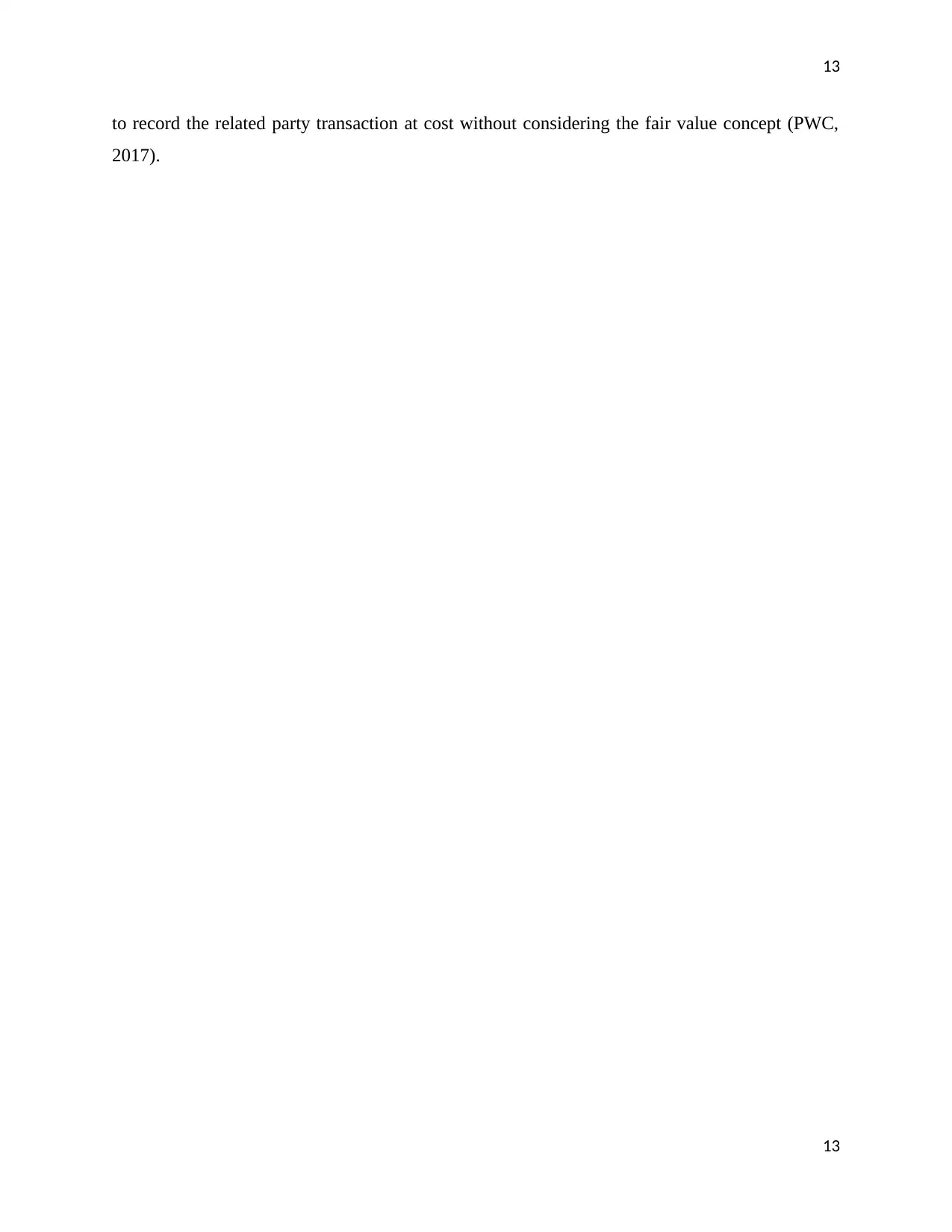
13
to record the related party transaction at cost without considering the fair value concept (PWC,
2017).
13
to record the related party transaction at cost without considering the fair value concept (PWC,
2017).
13
Paraphrase This Document
Need a fresh take? Get an instant paraphrase of this document with our AI Paraphraser
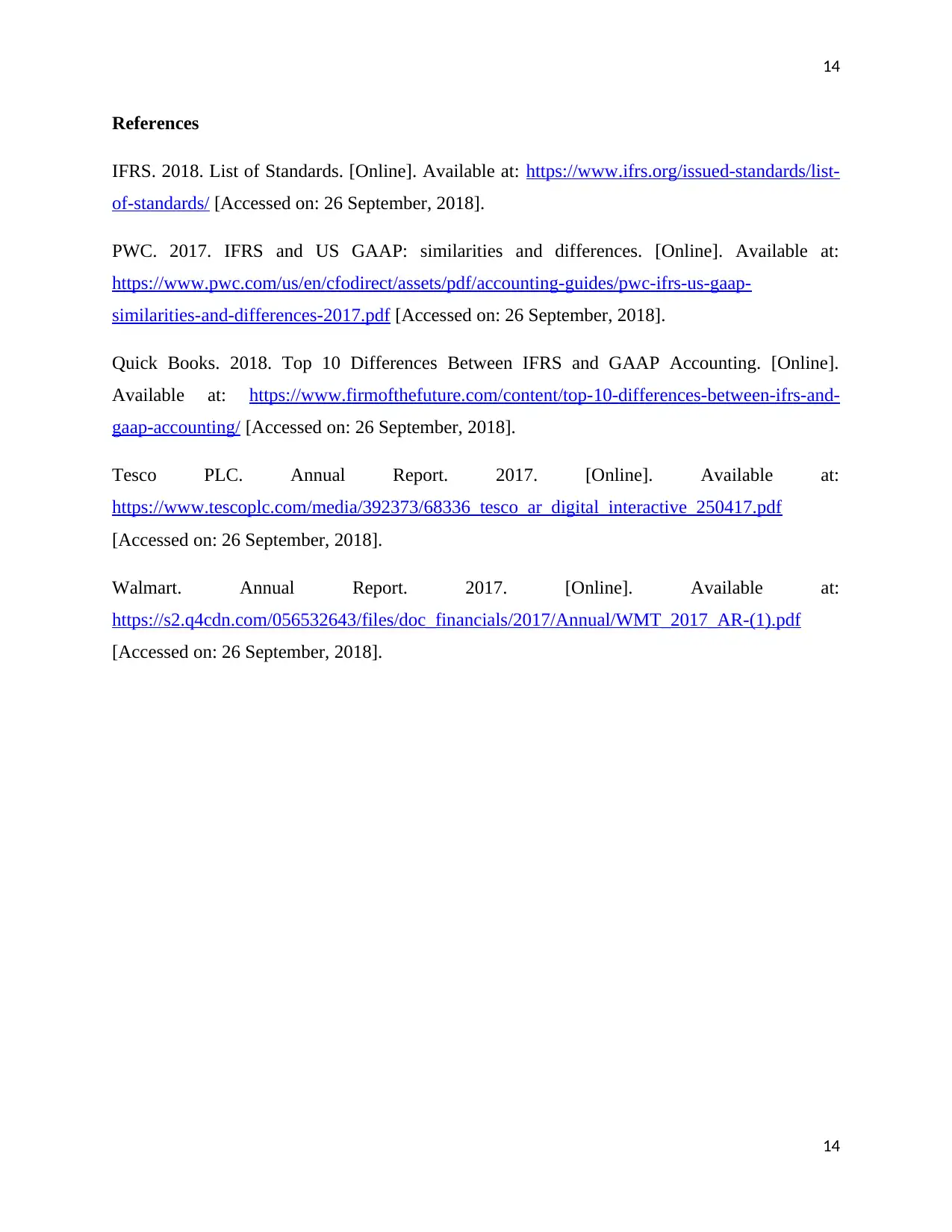
14
References
IFRS. 2018. List of Standards. [Online]. Available at: https://www.ifrs.org/issued-standards/list-
of-standards/ [Accessed on: 26 September, 2018].
PWC. 2017. IFRS and US GAAP: similarities and differences. [Online]. Available at:
https://www.pwc.com/us/en/cfodirect/assets/pdf/accounting-guides/pwc-ifrs-us-gaap-
similarities-and-differences-2017.pdf [Accessed on: 26 September, 2018].
Quick Books. 2018. Top 10 Differences Between IFRS and GAAP Accounting. [Online].
Available at: https://www.firmofthefuture.com/content/top-10-differences-between-ifrs-and-
gaap-accounting/ [Accessed on: 26 September, 2018].
Tesco PLC. Annual Report. 2017. [Online]. Available at:
https://www.tescoplc.com/media/392373/68336_tesco_ar_digital_interactive_250417.pdf
[Accessed on: 26 September, 2018].
Walmart. Annual Report. 2017. [Online]. Available at:
https://s2.q4cdn.com/056532643/files/doc_financials/2017/Annual/WMT_2017_AR-(1).pdf
[Accessed on: 26 September, 2018].
14
References
IFRS. 2018. List of Standards. [Online]. Available at: https://www.ifrs.org/issued-standards/list-
of-standards/ [Accessed on: 26 September, 2018].
PWC. 2017. IFRS and US GAAP: similarities and differences. [Online]. Available at:
https://www.pwc.com/us/en/cfodirect/assets/pdf/accounting-guides/pwc-ifrs-us-gaap-
similarities-and-differences-2017.pdf [Accessed on: 26 September, 2018].
Quick Books. 2018. Top 10 Differences Between IFRS and GAAP Accounting. [Online].
Available at: https://www.firmofthefuture.com/content/top-10-differences-between-ifrs-and-
gaap-accounting/ [Accessed on: 26 September, 2018].
Tesco PLC. Annual Report. 2017. [Online]. Available at:
https://www.tescoplc.com/media/392373/68336_tesco_ar_digital_interactive_250417.pdf
[Accessed on: 26 September, 2018].
Walmart. Annual Report. 2017. [Online]. Available at:
https://s2.q4cdn.com/056532643/files/doc_financials/2017/Annual/WMT_2017_AR-(1).pdf
[Accessed on: 26 September, 2018].
14
1 out of 14
Related Documents
Your All-in-One AI-Powered Toolkit for Academic Success.
+13062052269
info@desklib.com
Available 24*7 on WhatsApp / Email
![[object Object]](/_next/static/media/star-bottom.7253800d.svg)
Unlock your academic potential
© 2024 | Zucol Services PVT LTD | All rights reserved.





